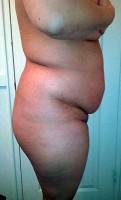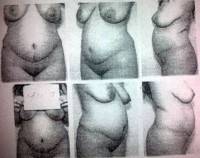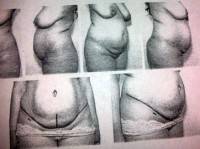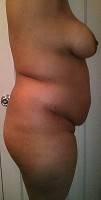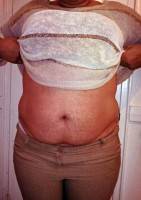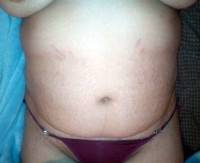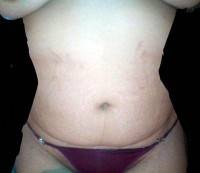Abdominoplasty with rectus plication
Is muscle tightening always done in a tummy tuck?
First of all you did not have a “full” tummy tuck.
That would have included tightening the loose muscles (rectus plication) in addition to the skin and fat removal.
The only time I do not do muscle tightening as part of the procedure is if: 1) The patient requests that it not be done or 2) The patient does not have loosening of her abdominal muscles.
Regarding the first, there is the occasional patient who simply does not want to go through the extra post-operative pain that is associated with this part of the procedure.
Regarding the second, there is a rare patient who, after pregnancies or weight loss still has tight muscles. Your photos sugest that you had some muscle laxity prior to surgery and, obviously, that it is still present.
It is hard to tell exactly without doing an exam, but I get the impression from your post-op photos that excess subcutaneous fat is really not a significant issue. So, in my opinion, liposuction would not be of help. For you to get the flat tummy you want, you will need to have the muscle tightening done.
I have had to go back and redo the repair in a couple of patients who have re-stretched their abdominal muscles by exercising too early, and the results have been very good. This is similar to what would be required in your case. The procedure should take about 2 hours. (Robert Stroup, Jr., MD, FACS, Cleveland Plastic Surgeon)
Why Would a Dr Not Do Muscle Tightening?
We almost always do a muscle/fascial tightening when we do a full tummy tuck. Occasionally I come across a patient who has excess skin but the fascia and muscles of the abdominal wall are not stretched, and we discuss not doing a muscle tightening in that case.
The recovery and discomfort are less. However, in looking at your photos, it would appear that your abdominal protrusion, which may be due to muscle/fascial laxity, has not been improved very much. If this is the case, liposuction would not improve this, of course. Please keep in mind that excess thickness of subcutaneous fatty tissue (fat beneath the skin) will restrict the amount of skin tightening and flattening of the tummy, and intra-abdominal fatty tissue excess (fat in your abdomen around your bowels) will restrict the amount of flattening of the tummy EVEN with muscle/fascial tightening.
If you lie down on your back and your tummy does not flatten out very well, you have excess intra-abdominal fat and fascial tightening may give you only limited improvement without further weight loss. (Robert M. Grenley, MD, Seattle Plastic Surgeon)
Muscle Plication
You may benefit from muscle plication, but you can also benefit some from weight loss. The intraabdominal contents contain fat around your intestine and in a structure called the omentum. Losing weight will thin this fat and cause less bulging of the abdomen outward.
In addition, if you lose this weight before undergoing the muscle plication, the plication can be made tighter than it could at your current weight. (Donald Griffin, MD, Nashville Plastic Surgeon)
Abdominoplasty with or without rectus plication
From photos alone it is difficult to determine if you have lots of fascial laxity or a generous portion of intraabdominal fat or both. One trick is to lie down and see how much flatter your abdomen gets.
If there is very little change then you are less likely to get more than a short term improvement with fascial plication. Seek a board certificated plastic surgeon and allow them the benefit of examining you. (Craig Harrison, MD, PA, Tyler Plastic Surgeon)
UnhappyTummy Tuck
I am sorry you are not happy with your result. While you and the doctors are discussing the absence of muscle repair as a potential issue, I don’t believe it would have mattered much. In addition to the extra skin and some fat under the skin, it appears you had a significant amount of intra-abdominal fat, the kind that can’t be removed with any surgical procedure. Had the doctor repaired or plicated the muscle, allowing for some flattening of your belly, it would be likely that a bulge would recure due to intra-abdominal pressure, and you would probably not look much different.
Most doctors feel that simultaneous liposuction of the abdomen with a tummy tuck procedure is not prudent, and increases your risk of wound healing problems. That is why most do not do both procedures simultaneously, and offer liposuction of the abdomen as a secondary procedure. Determining if liposuction will help would require a physical exam. A revision tummy tuck that might include not only liposuction, but also muscle plication could be considered, but only if your intra-abdominal fat content is not considered an issue by a competant, experienced surgeon.
You should discuss these issues with your doctor and see what he says. You might also consider getting a second opinion. (Gerald Minniti, MD, FACS, Beverly Hills Plastic Surgeon)
Do you always tighten the muscles with tummy tuck?
It’s hard to comment on the interaction that you had with your surgeon prior to your surgery. But they are reasons why a person may or may not have muscle tightening associated with the tummy tuck. When a woman has a child, the abdominal wall usually has extra room. The muscles are lax. There is additional space in the abdomen because there is no longer a child in the womb and the uterus shrinks. In this situation tightening the abdominal wall muscles that have stretched are in pregnancy will usually be of benefit and give long-term improvement. In a patient who is heavy, the room may be taken up by fat inside the abdomen. In this case tightening of the muscles may be less gratifying.
Even with abdominal wall tightening if there’s too much force (weight) inside the abdomen, the abdominal muscles will relax and either find a new equilibrium or go back to where they were. The body is smarter than doctor and will respond to the forces that are put upon it.
When I consult with my own patients I explain that a slender person will stay more flat, a medium weight person may see improvement but will find a new equilibrium, and I rarely tighten people who are very heavy because not only will they stretch back again but they are often sore and uncomfortable during the process. Sometimes I don’t tighten the muscles for other reasons. If a patient has medical conditions which make a muscle tightening more risky I may advise against it. If a patient doesn’t need it I may advise against it, or if a patient wishes a quicker and less painful recovery the muscles do not need to be tightened.
I think it’s important that people know that a non muscle tightening tummy tuck is available to them. Sometimes people have their fatty fullness outside of the abdomen. In this case muscle tightening will not help, but liposuction well. I personally do not perform liposuction of the upper abdomen that will be pulled and moved during the tummy tuck because it can increase the risk of healing problems.
I don’t mind liposuction of the flanks or hips because that does not impact upon the blood supply of the area that I’m moving. So if a patient of mine has residual fatty fullness after the skin has been tightened in the upper abdomen we discuss the possibility of a staged liposuction. So you see your surgeon may have had a variety of reasons for not tightening the muscles.
Staging liposuction in some cases can make sense and the only way to know his thinking is to discuss it with him further. If you’re no longer in the area you may wish to see a board certified plastic surgeon in your location. While muscles can still be tightened, on physical examination your original or your new surgeon may be able to guide you as to whether it will be worth your while given your height and weight. I hope this helps to clarify some of the thinking that goes into tummy tuck surgery. (Adam Tattelbaum, MD, Washington DC Plastic Surgeon)
